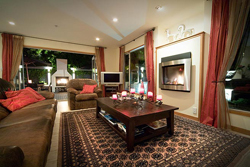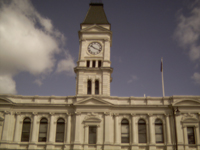 The early discovery of limestone, an excellent building material,
helped to contribute to the
Oamaru's
excellent appearance. Limestone
is easy to carve and mould which enabled many of the of the
architects and masons to produce works in fashionable styles
of architecture. This, combined with the wealth of the 19th
Century, have resulted in the one of the finest 19th century
streets in
New Zealand
The early discovery of limestone, an excellent building material,
helped to contribute to the
Oamaru's
excellent appearance. Limestone
is easy to carve and mould which enabled many of the of the
architects and masons to produce works in fashionable styles
of architecture. This, combined with the wealth of the 19th
Century, have resulted in the one of the finest 19th century
streets in
New Zealand
-
Oamaru Blue Penguin Colony - Simply the cutest little critters you're likely to encounter in Oamaru - or anywhere in Otago. The Blue Penguin Colony in the old harbour area is a breeding area - where the inches-high penguins return every year. Visit during the breeding season (mid-Oct to mid-Jan) for maximum numbers coming ashore at dusk to feed their young.
-
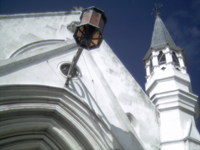 St
Pauls Presbyterian Church on Coquet Street was built
in 1875 on the the foundations of an earlier church designed
by Dunedin architect William Mason in 1864. The previous "unorthodox" building
was unfavoured by the parish and replaced by the current
church designed by Forrester and Lemon and was opened
in Feburary, 1876.
St
Pauls Presbyterian Church on Coquet Street was built
in 1875 on the the foundations of an earlier church designed
by Dunedin architect William Mason in 1864. The previous "unorthodox" building
was unfavoured by the parish and replaced by the current
church designed by Forrester and Lemon and was opened
in Feburary, 1876. -
St Lukes Anglican Church - cnr of Itchen and Tees Streets - The south end of the nave of the prominent Anglican church was built in 1866 and the nave was completed in 1876. The spire and chancel were added in 1913 and the west porch in 1922. Rumsey and Jackson designed the first sections while J.M. Forrester designed the rest. Wood carving is by English-trained F. G. Gurnsey.
-
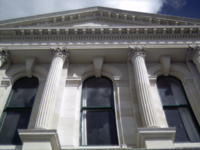 Designed
by Forrestor and Lemon, the North
Otago Museum (Thames Street) was originally the
Oamaru Athenaeum (a subscription library) and Mechanics
Institute in 1882. It replaced an earlier Athenaeum which
was built on the same site in 1867. When the public library
was built, the Athenaeum became a museum and archive serving
the
Oamaru
district.
Designed
by Forrestor and Lemon, the North
Otago Museum (Thames Street) was originally the
Oamaru Athenaeum (a subscription library) and Mechanics
Institute in 1882. It replaced an earlier Athenaeum which
was built on the same site in 1867. When the public library
was built, the Athenaeum became a museum and archive serving
the
Oamaru
district. -
National Bank - Thames Street - designed by Robert Lawson the National Bank was originally built for the Bank of Otago in 1871. The Bank of Otago was absorbed by National Bank in 1875 who retained this elegant building.
-
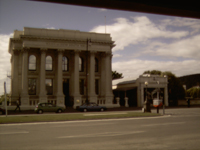 The Forrester
Gallery (Thames Street) was formerly The Bank of
New South Wales. Designed by Dunedin architect Robert
Lawson in 1883 - the Forrester
Gallery makes an excellent neighbour to the impressive National
Bank. The Bank was converted to a gallery in 1983.
The Forrester
Gallery (Thames Street) was formerly The Bank of
New South Wales. Designed by Dunedin architect Robert
Lawson in 1883 - the Forrester
Gallery makes an excellent neighbour to the impressive National
Bank. The Bank was converted to a gallery in 1983. -
NZ Loan and Mercantile Warehouse (Harbour Street) was designed by Dennison and Grant and built in 1882 as a three-storey Victorian warehouse for the then largest stock and station agency in New Zealand , the NZ Loan and Mercantile company. The building was able to handle 100,000 sacks of grain and contained four grain lifts. The warehouse is now occupied by the NZ Malt Wiskey Company Ltd.
-
Smiths Grain Store was built by James Johnston (a rival to Forrester and Lemon) in 1881/2. The Grain Store was capable of storing of 30,000 sacks of grain. Oamaru Mail occupied the building from 1906 to 1970. If you know who currently occupies this building please contact me.
-
St Patricks Basilica - This Catholic basilica was designed by F. W. Petre who also designed the Basilica in Christchurch and St Josephs in Dunedin The first phase of construction commenced in 1893 and construction in 1918.
-
 The Former
Post Office (Thames Street) now serves as the home
of Waitaki
District Council. This limestone building was designed
without the clocktower by Forrester and Lemon in 1883.
The 28 meter high tower was added by Thomas Forrester's
son John in 1903. The clock is a memorial to the Honourable
John McLean and was donated by his nephew Sir John Buckley.
The Former
Post Office (Thames Street) now serves as the home
of Waitaki
District Council. This limestone building was designed
without the clocktower by Forrester and Lemon in 1883.
The 28 meter high tower was added by Thomas Forrester's
son John in 1903. The clock is a memorial to the Honourable
John McLean and was donated by his nephew Sir John Buckley. -
Criterion Hotel - Tyne Street - Victorian Italiante style building by Forrester and Lemon built in 1877. The hotel closed in 1906 when Oamaru went dry. The bar reopened in 1998. The building is now administered by the Oamaru Whitestone Civic Trust which was formed in 1989 to purchase, restore and adminster buildings in the old town area of Oamaru
-
Customs House (Tyne Street) is now home to North Otago Art Society, the former Customs House has also served as the Waitaki County Council and the Buffalo Lodge. As with many other buildings in Oamaru, it was designed by Ferrester and Lemon. Dates from 1833.
-
The former Harbour Board Office, Harbour Street, built in 1876 as ornamented Venetian Renaissance building by Forrester and Lemon building is now the HQ of the Oamaru Whitestone Civic Trust.
-
Union Bank - Tyne Street - Former Union Bank of Australia was, in commond with many Oamaru buildings, designed by Forrester and Lemon and built in 1878/9. An example of the Venetian Palazzo style in commercial architecture in New Zealand .
-
First Post Office - Thames Street is the oldest surviving public building in Oamaru having been built in 1864. It is the only example of W H Clayton's work which remains in Oamaru and is significantly simpler that the more elaborate neighbours including the adjacent second Post Office which replace it in 1884. A clock was supposed to be installed in the circular openings in tower. The first Post Office now serves as a restaurant.
-
Oamaru Opera House - Designed by J. M. Forrester and completed local contractors H Winsley. The Oamaru Opera House was opened on the 7th October 1907 at a cost of 10,600 pounds. The Oamaru Opera House has variously hosted the Oamaru Borough Council, the Council Chamber as well as theatre, ballet concerts and cinema etc.
